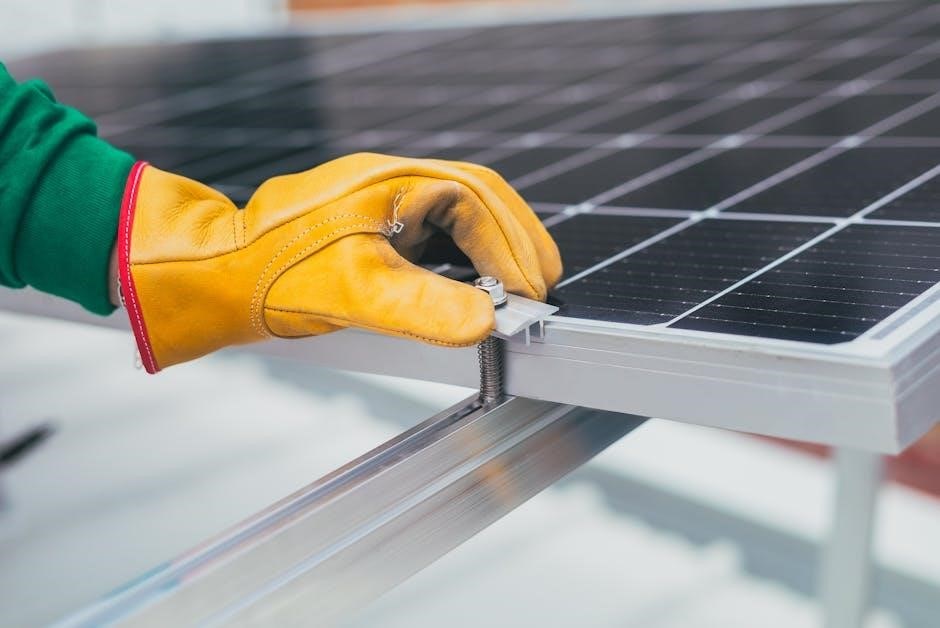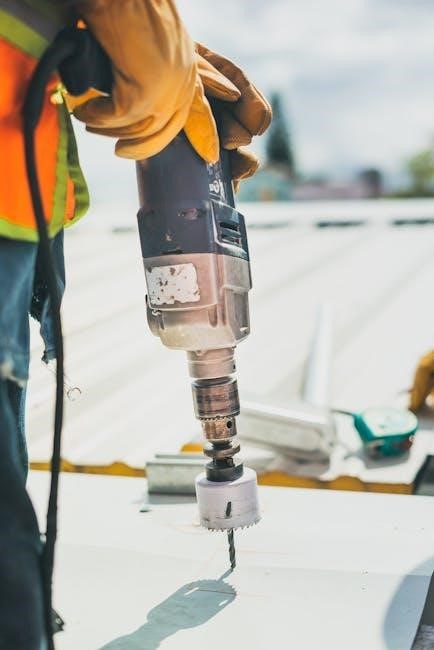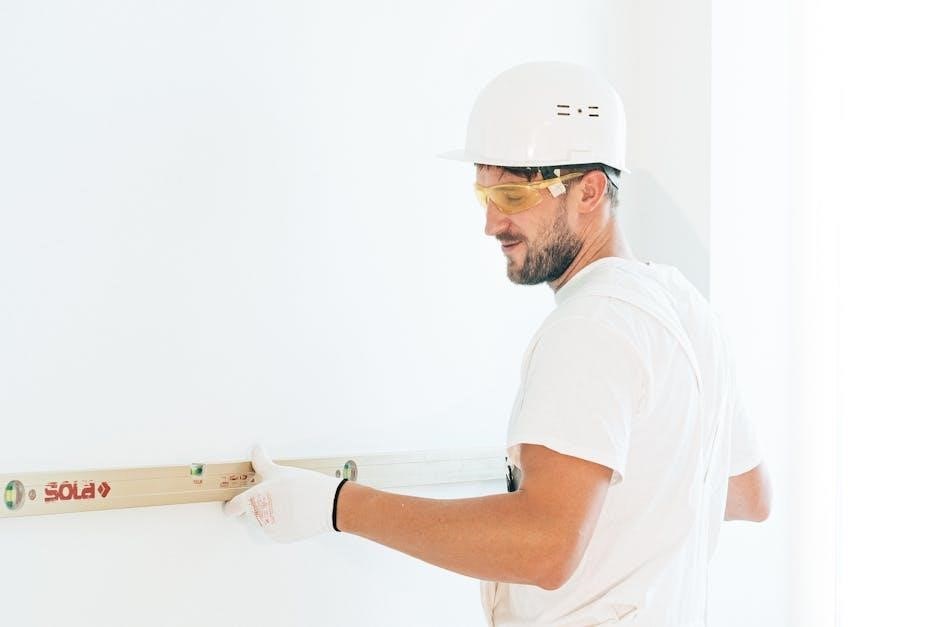Honeywell installation manuals provide essential guidance for installing and configuring Honeywell systems, ensuring safety, compatibility, and optimal performance. They offer step-by-step instructions, troubleshooting tips, and system optimization advice.
Overview of Honeywell Products
Honeywell offers a diverse range of products, including thermostats, security systems, and smart home devices, designed to enhance home comfort and security. Their thermostats, such as the YTH8321WF1044/U and TH8321WF1001/U, provide advanced temperature control and Wi-Fi connectivity. Honeywell systems are known for their reliability, energy efficiency, and seamless integration with smart home platforms, ensuring optimal performance and user convenience.
Importance of Following the Manual
Following Honeywell installation manuals ensures proper system setup, safety, and functionality. Incorrect installation can lead to malfunctions, safety risks, or reduced efficiency. The manual provides specific instructions for models like YTH8321WF1044/U and TH8321WF1001/U, covering wiring, programming, and troubleshooting. Adhering to guidelines ensures compatibility, optimizes performance, and prevents issues like connectivity problems or thermostat failures, guaranteeing a reliable and efficient system operation.

Understanding System Compatibility
Understanding system compatibility ensures Honeywell products like YTH8321WF1044/U integrate seamlessly with existing HVAC systems, as outlined in installation manuals. Proper checks prevent issues and guarantee efficient operation.
Checking Compatibility with Existing Systems
Checking compatibility with existing systems is crucial for a smooth Honeywell installation. Verify wiring configurations, system types (e.g., heat pump or conventional), and ensure components like thermostats (e.g., YTH8321WF1044/U) align with your setup. Refer to the manual for specific compatibility guidelines to avoid installation issues and guarantee optimal performance. Proper checks ensure seamless integration and prevent operational problems. Always confirm compatibility before proceeding with installation.
Tools and Materials Needed
Installations require specific tools and materials. Use screwdrivers, wire strippers, and voltage testers. Honeywell recommends using compatible tools for safety and functionality. Gather materials like wires, connectors, and mounting hardware. Ensure all components match your system type. Refer to your manual for a detailed list. Proper tools ensure a secure and efficient installation, preventing potential issues. Always verify compatibility before starting the process.

Pre-Installation Wiring Requirements
Understand wiring diagrams thoroughly. Ensure compatibility with existing systems. Follow safety guidelines, such as turning off power before starting. Verify wire labels and connections match Honeywell specifications.
Understanding Wiring Diagrams
Wiring diagrams are critical for successful Honeywell system installation. They provide visual representations of connections, ensuring correct wire placement. Color-coding and labels help identify terminals. Always cross-reference diagrams with your system’s specific manual. Verify compatibility with your HVAC setup. Common issues include misplaced wires or faulty connections. Consult Honeywell resources or contact support for clarification if needed. Accurate wiring ensures safe and efficient system operation.
Safety Precautions
Always disconnect power before starting installation to avoid electrical shocks. Verify system compatibility and use appropriate tools. Follow wiring diagrams and manufacturer guidelines to prevent hazards. Ensure proper grounding and avoid shortcuts. Wear protective gear and keep the area clear. Double-check connections to prevent malfunctions. Adhere to safety protocols to ensure a secure and efficient installation process. Consult the manual for specific precautions tailored to your Honeywell system.

Step-by-Step Installation Guide
Follow the guide carefully to ensure proper installation. Align with Honeywell’s instructions for a seamless process. Prepare tools and materials beforehand to avoid delays or errors during setup.
Thermostat Installation Process
Begin by turning off power to the HVAC system. Remove the old thermostat and label wires for identification. Mount the new Honeywell thermostat, ensuring proper alignment. Connect wires according to the wiring diagram, matching colors to corresponding terminals. Restore power and test the system. Set the system mode and desired temperature, then press “Hold” to activate. Verify functionality and adjust settings as needed for optimal performance.
Connecting Sensors and Additional Devices
Power off the system before connecting sensors. Attach temperature or humidity sensors to the thermostat, ensuring secure wiring connections. For additional devices, follow the manufacturer’s wiring diagram. Connect smart home integrations or accessories like motion detectors. Verify all connections are tight and properly configured. Restore power and test each device’s functionality. Use the Honeywell app or manual to configure settings for integrated devices.
Configuring Your Honeywell System
Configure your Honeywell system by accessing settings through the thermostat or app. Customize temperature schedules, smart home integrations, and advanced features to optimize performance and energy efficiency.
Basic Programming and Settings
Begin by setting your Honeywell system’s basic parameters, such as temperature range and scheduling. Use the thermostat interface to program daily or weekly schedules. Select system modes like Heat, Cool, or Off. Adjust fan settings and ensure proper date and time configuration. These foundational settings ensure smooth operation and energy efficiency. Refer to the manual for step-by-step guidance on initial setup and customization.
Advanced Configuration Options
Delve into advanced settings like geofencing, smart recovery, and humidity control for enhanced system performance. Customize temperature swings, fan operation, and energy-saving modes. Utilize remote access features through the Honeywell app for seamless control. Explore scene-based automation and integrate with smart home devices for a tailored experience. Refer to the manual for detailed instructions on unlocking these sophisticated capabilities without compromising simplicity.

Troubleshooting Common Issues
Address common issues like error codes, device malfunctions, or connectivity problems. Refer to the manual for diagnostic tools and step-by-step solutions to ensure proper system functionality and resolve faults efficiently.
Identifying and Resolving Common Installation Problems
Common installation issues include error codes, device communication failures, or wiring mismatches. Refer to the manual for troubleshooting guides, such as checking connections, verifying compatibility, or resetting systems. Address issues like faulty sensors or outdated firmware by following step-by-step solutions. Ensure proper functionality by resolving these problems early to avoid system malfunctions and ensure seamless operation. Always consult the manual for specific error code explanations and fixes.
Understanding Error Codes and Solutions
Honeywell systems display error codes like E09, E30, or E47, indicating issues such as communication failures or sensor malfunctions. Refer to the manual for code meanings and solutions. For example, E09 may require checking wiring connections, while E30 could involve resetting the system. Addressing these codes promptly ensures proper functionality and prevents further complications. Always consult the manual for specific troubleshooting guidance.
Maintaining Your Honeywell System
Regular maintenance ensures optimal performance, safety, and longevity of Honeywell systems. Schedule checks, clean components, and update software for reliable operation.
Regular Maintenance Tips
Regular maintenance is crucial for Honeywell systems. Clean filters monthly to ensure proper airflow and efficiency. Check wiring connections to prevent malfunctions. Replace batteries in thermostats annually. Update firmware regularly for optimal performance. Inspect sensors for dust or damage. Schedule professional check-ups annually to identify potential issues early. Maintain user manuals for quick reference during troubleshooting.
Updating Firmware and Software
Regularly update Honeywell firmware and software to ensure optimal performance and security. Use the Honeywell Home app or visit the official website for the latest versions. Always follow the installation manual’s instructions to avoid compatibility issues. Ensure a stable internet connection during updates and restart devices post-update for optimal functionality.

Upgrading or Replacing Components
Upgrading or replacing Honeywell components ensures system efficiency and compatibility. Always refer to the installation manual for compatibility checks and follow safety guidelines to avoid malfunctions.
When to Upgrade Your System
Upgrade your Honeywell system when experiencing performance issues, outdated technology, or the need for advanced features. Consider upgrading if your system is no longer meeting your needs, has compatibility issues, or requires frequent repairs. New features like smart home integration or improved energy efficiency may also warrant an upgrade. Always follow Honeywell’s guidelines for a seamless upgrade process.
Steps for Replacing Components
When replacing components, ensure the system is powered off and follow safety precautions. Use the wiring diagram to identify connections and disconnect wires carefully. Remove the old component and install the new one, securing it properly. Reconnect wires as per the diagram and test functionality. Refer to Honeywell’s manual for specific instructions to ensure compatibility and optimal performance. Use compatible tools and materials for a smooth replacement process.

Honeywell Smart Home Integration
Honeywell smart home integration allows seamless connectivity with platforms like Amazon Alexa and Google Home, enabling voice control and enhanced smart device compatibility for optimal home automation.
Connecting to Smart Home Systems
Connect Honeywell devices to smart home systems like Amazon Alexa or Google Home for voice control and seamless integration. Use the Honeywell Home app to link your thermostat or security system to your smart home network. Ensure your devices are compatible and follow the app’s setup instructions. This integration allows for centralized control, voice commands, and enhanced home automation functionality.
Using Voice Assistants
Honeywell systems seamlessly integrate with popular voice assistants like Amazon Alexa and Google Home. Enable voice control by linking your Honeywell device to your smart home network. Use the Honeywell Home app to set up voice commands for temperature adjustments or system checks. This integration enhances convenience, allowing hands-free control and improving your smart home experience with intuitive voice commands.
Accessing Additional Resources
Honeywell provides comprehensive online resources, including detailed manuals, guides, and troubleshooting tips. Visit their official website or use the Honeywell Home app for updates and support.
Online Manuals and Guides
Honeywell offers extensive online resources, including detailed installation manuals and user guides, accessible via their official website. These resources provide step-by-step instructions, wiring diagrams, and troubleshooting tips for various Honeywell systems.
Visitors can search by product model to find specific guides, ensuring accurate and relevant information for their installation needs. Regular updates guarantee compatibility with the latest system versions and features.
Contacting Customer Support
Honeywell provides multiple avenues for customer support, including phone, email, and live chat options. Their official website offers detailed contact information and regional support centers. Additionally, online resources such as FAQs, forums, and troubleshooting guides are available 24/7 to address common issues and installation queries. Technical experts are ready to assist with any challenges, ensuring a smooth experience for users.
POST-Installation Checks
POST-Installation Checks involve verifying system functionality, testing performance, and ensuring all components operate seamlessly. These steps confirm the installation’s success and reliability.
Testing System Performance
Testing system performance ensures all components function correctly after installation. Verify thermostat settings, sensor accuracy, and connectivity. Monitor temperature control, heating/cooling cycles, and system responsiveness. Check for error codes and ensure smooth operation across all modes. Consult the manual for specific test procedures and troubleshooting guidance to confirm optimal performance and reliability.
Ensuring Proper Functionality
After installation, verify each feature operates as intended. Check thermostat scheduling, remote access, and sensor integration. Ensure all wiring connections are secure and compatible. Review the manual for specific functionality tests, such as cooling, heating, and fan modes. Address any issues promptly to guarantee reliable operation and maximize system efficiency and user satisfaction.

Best Practices for Installation
Adhere to Honeywell guidelines, use recommended tools, and verify system compatibility. Ensure all safety precautions are followed and connections are secure for optimal performance and reliability.
Following Manufacturer Guidelines
Adhering to Honeywell’s installation guidelines ensures safety, compatibility, and optimal system performance. Always verify compatibility with existing systems, use recommended tools, and follow wiring diagrams. Ensure proper connections, and consult the manual for specific settings. This approach minimizes errors and guarantees reliable operation, aligning with industry standards and Honeywell’s quality assurance protocols for a seamless setup experience.
Ensuring Compliance
Ensuring compliance with Honeywell installation manuals is crucial for meeting regulatory requirements and safety standards. Verify local building codes, obtain necessary permits, and follow environmental regulations. Compliance guarantees system safety, efficiency, and adherence to legal standards, preventing potential legal issues or performance malfunctions. Always align installation practices with Honeywell’s guidelines and industry norms for a reliable and lawful setup.

Frequently Asked Questions
Common queries include resolving connectivity issues, troubleshooting error codes, and ensuring system compatibility. Users often seek guidance on installation steps and optimizing Honeywell system performance effectively.
Common Queries and Solutions
Users often ask about resolving connectivity issues, troubleshooting error codes, and ensuring proper system installation. Common problems include thermostat responsiveness, wiring mismatches, and advanced feature setup. Solutions typically involve checking connections, updating firmware, or referring to the manual for specific error code explanations. Additional resources like online guides and customer support can provide detailed assistance for complex issues.
- Thermostat connectivity issues: Check Wi-Fi settings and ensure the device is properly paired.
- Installation errors: Verify wiring diagrams and system compatibility before proceeding.
- Advanced features: Consult the manual for geofencing or smart home integration setup.
Addressing User Concerns
Users often express concerns about system compatibility, wiring complexity, and connectivity issues. Addressing these involves ensuring compatibility with existing systems, following manual guidelines, and utilizing troubleshooting resources. Common concerns also include unclear error messages and advanced feature setups, which can be resolved by referencing the manual or contacting Honeywell support for personalized assistance.
- Compatibility concerns: Verify system requirements before installation.
- Connectivity issues: Ensure proper wiring and network configuration.
- Advanced features: Refer to the manual or support for detailed guidance.
Successful installation ensures optimal performance and safety. Always follow guidelines, verify compatibility, and use troubleshooting resources. For further assistance, refer to Honeywell manuals and customer support.
Final Tips for Successful Installation
Ensure all connections are secure and double-check wiring diagrams. Use manufacturer-recommended tools and follow safety guidelines. Test system functionality post-installation and refer to troubleshooting guides if issues arise. Regularly update firmware and maintain the system for optimal performance. Always consult Honeywell manuals or contact support for unresolved concerns. Proper installation ensures reliability, efficiency, and safety of your Honeywell system.
Resources for Further Assistance
For additional support, visit Honeywell’s official website for detailed manuals, troubleshooting guides, and firmware updates. Explore community forums and tutorials for shared experiences and solutions. Contact Honeywell customer support directly for personalized assistance. Ensure you have the correct model number when seeking help, as resources vary by product; Updated guides and FAQs are regularly posted online to address common issues and improve installation success.

References
Honeywell’s official installation guides, technical notes, and product manuals are essential references. These documents provide detailed specifications, diagrams, and procedures for accurate and safe system installations. Visit Honeywell’s website for downloadable resources tailored to your specific model and needs.
Recommended Tools and Materials
For a successful Honeywell installation, gather essential tools like a multimeter, screwdrivers, and wire strippers. Materials such as compatible wires, connectors, and mounting hardware are crucial. Ensure you have a ladder, safety gloves, and goggles for protection. Refer to Honeywell’s official manual for specific recommendations tailored to your system. Always use high-quality, compatible components to ensure reliability and performance.
Suggested Reading
Explore Honeywell’s official guides, technical specifications, and user forums for in-depth insights. Review supplementary materials like case studies and manufacturer-authorized resources. Check out Honeywell’s website for updated publications and downloadable content. Additionally, consider community discussions and reviews for practical advice and real-world experiences. These resources will enhance your understanding and provide valuable tips for a seamless installation process.
